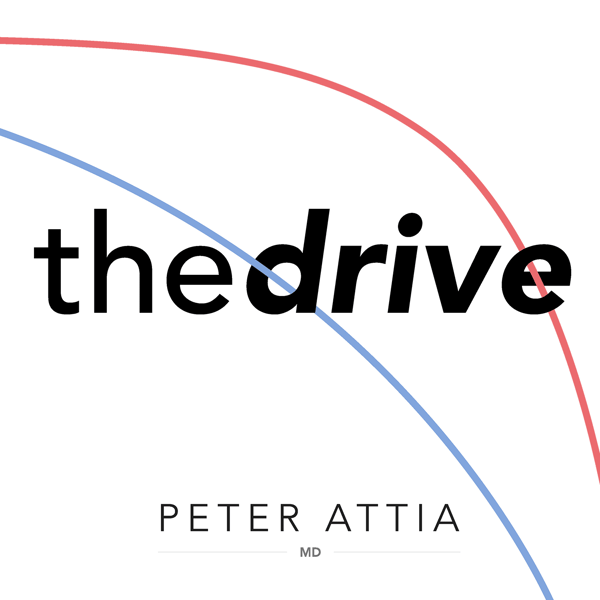#238 – AMA #43: Understanding apoB, LDL-C, Lp(a), and insulin as risk factors for cardiovascular disease
The Peter Attia Drive
Peter Attia, MD
4.7 • 7.3K Ratings
🗓️ 16 January 2023
⏱️ 24 minutes
🧾️ Download transcript
Summary
View the Show Notes Page for This Episode
Become a Member to Receive Exclusive Content
Sign Up to Receive Peter’s Weekly Newsletter
In this “Ask Me Anything” (AMA) episode, Peter answers questions related to the leading cause of death in both men and women—atherosclerotic cardiovascular disease (ASCVD). He highlights the most important risk factors for ASCVD, such as apoB, LDL, hyperinsulinemia, and Lp(a), and explains the mechanism by which they confer risk and how these factors are interrelated. Peter also dives deep into the data around apoB to try to answer the question of how much residual risk is conferred for ASCVD through metabolic dysfunction once you correct for apoB. He also looks at the data around lifetime risk reduction of ASCVD in the context of low apoB.
If you’re not a subscriber and are listening on a podcast player, you’ll only be able to hear a preview of the AMA. If you’re a subscriber, you can now listen to this full episode on your private RSS feed or our website at the AMA #42 show notes page. If you are not a subscriber, you can learn more about the subscriber benefits here.
We discuss:
- A racecar analogy for understanding atherosclerotic cardiovascular disease [2:00];
- Defining and differentiating apoB and LDL-C [10:00];
- The interrelated nature of insulin levels, apoB, triglycerides, and ASCVD parameters [13:00];
- Another way that hyperinsulinemia plays a role in endothelial dysfunction [18:00];
- Why Peter uses the oral glucose tolerance test (OGTT) with all patients [20:15];
- Is there any evidence that hyperinsulinemia is an independent contributor to ASCVD? [23:00];
- Thinking through risk in the context of high-fat diets resulting in improved metabolic metrics but with an elevation of apoB/LDL-C [27:30];
- Thinking through risk in the context of low apoB but higher than normal triglyceride levels [32:15];
- The importance of lowering apoB for reducing ASCVD risk [38:15];
- Data on men and women with familial hypercholesterolemia that demonstrates the direct impact of high apoB and LDL-C on ASCVD risk [47:45];
- Importance of starting prevention early, calcium scores, and explaining causality [52:30];
- Defining Lp(a), its impact on ASCVD risk, and what you should know if you have high Lp(a) [56:30];
- Lp(a) and ethnic differences in risk [1:00:30];
- Why someone with elevated Lp(a) should consider being more aggressive with apoB lowering strategies [1:05:00];
- Addressing the common feeling of hesitancy to taking a pharmacologic approach to lower ASCVD risk [1:07:15];
- Peter’s take on the 2022 Formula 1 season and thoughts on 2023 [1:15:15]; and
- More.
Connect With Peter on Twitter, Instagram, Facebook and YouTube
Transcript
Click on a timestamp to play from that location
| 0:00.0 | Hey everyone, welcome to a sneak peek, ask me anything, or AMA episode of the Drive Podcast. |
| 0:16.5 | I'm your host, Peter Atia. |
| 0:18.3 | At the end of this short episode, I'll explain how you can access the AMA episodes in full, |
| 0:22.9 | along with a ton of other membership benefits we've created. |
| 0:26.0 | Before you can learn more now by going to peteratia-md.com forward slash subscribe. |
| 0:31.5 | So without further delay, here's today's sneak peek of the Ask Me Anything episode. |
| 0:39.8 | Welcome to Ask Me Anything Episode number 43. |
| 0:43.4 | I'm once again joined by Nick Stenson. |
| 0:46.3 | In today's episode, we answer a lot of follow-up questions we've had on some recent podcasts, |
| 0:51.5 | specifically around insulin hyperinsulinemia, APOB, LPLitLA, and how they all relate to how |
| 0:58.2 | a person should be thinking about their risk of atherosclerotic cardiovascular disease, |
| 1:02.9 | which is just as a reminder, the number one leading killer in the US worldwide for men, for women. |
| 1:09.4 | So one of the things we try to do in this podcast is really get at the data around how much residual risk |
| 1:17.0 | is conferred for ASCVD through metabolic dysfunction, once you correct for APOB. |
| 1:24.4 | And there are some things that I think we have data that we can speak to and we talk a lot about those things. |
| 1:28.7 | So for example, we get into the mechanism by which hyperinsulinemia increases the risk of ASCVD. |
| 1:35.2 | And of course, the question is once APOB is corrected forward, is that risk still exist? |
| 1:39.5 | Well, we attempt to tackle that. |
| 1:41.1 | We also talk about what Mendelian randomization tells us about lifetime risk reduction of ASCVD |
| 1:48.7 | in the context of low APOB. |
| 1:51.2 | So these are just a couple examples of some of the topics that we get into at a pretty nuanced level |
| 1:56.6 | in this podcast. |
... |
Please login to see the full transcript.
Disclaimer: The podcast and artwork embedded on this page are from Peter Attia, MD, and are the property of its owner and not affiliated with or endorsed by Tapesearch.
Generated transcripts are the property of Peter Attia, MD and are distributed freely under the Fair Use doctrine. Transcripts generated by Tapesearch are not guaranteed to be accurate.
Copyright © Tapesearch 2025.

